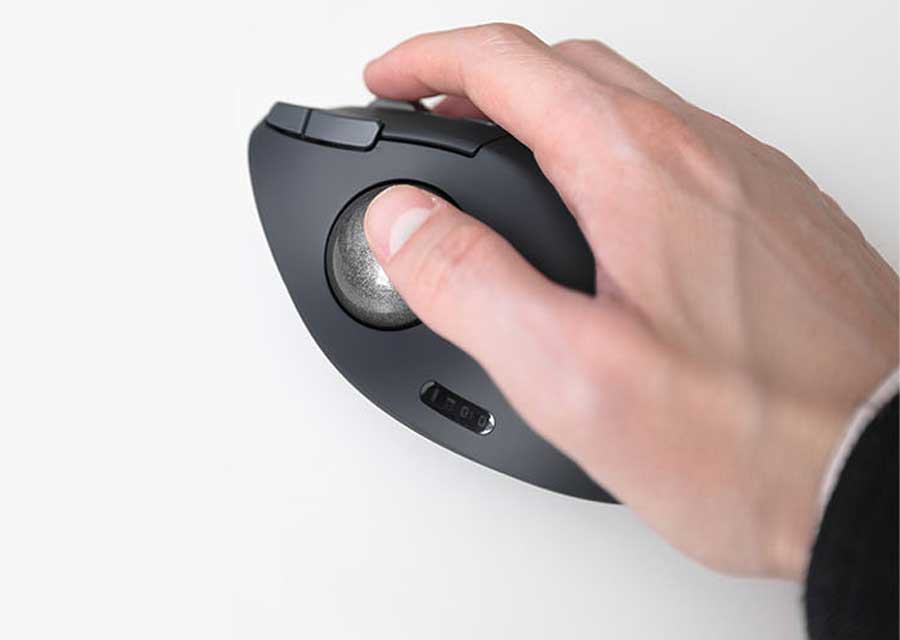Suggestions
- No Suggestions
Recommended Products
- No recommended searches
Site Pages
- No Related Site Pages


Featured by digital creator Cam DiCecca
"The TB550 is an excellent ergonomic trackball mouse that truly makes it hard to go back to using a regular mouse."
Combines the feel of a wireless mouse with the accuracy of an advanced trackball. A sculpted ergonomic design with 45° tilt helps improve wrist and forearm alignment providing more comfort during extended use.
 Up to 4 months of battery life
Up to 4 months of battery life 4D scroll wheel
4D scroll wheel 7 programmable buttons
7 programmable buttons 34mm ball with optical sensor
34mm ball with optical sensor Unique 45° tilt
Unique 45° tilt Dual wireless connection
Dual wireless connectionCam DiCecca, Digital creator & tech enthusiast


Cam DiCecca, Digital creator & tech enthusiast

"Having the ability to connect to 3 different devices via Bluetooth or the included USB dongle is great for people like me with multiple devices that I use daily, and having a USB-C port makes it convenient to charge. Plus, with the DPI button on the bottom, you can quickly adjust the cursor speed on the fly”.
See All FeaturesA trackball is a pointing device consisting of a ball held in a socket containing sensors to detect the ball’s rotation. It is typically used to move a cursor on a computer screen.
Unlike a traditional mouse where the device is moved across a surface to control the cursor, a trackball remains stationary while the user rolls the ball with their fingers or thumb to manipulate the cursor.
Reduced strain: Trackballs can reduce wrist and arm strain compared to traditional mice, as they allow for more ergonomic hand positions.
Space-saving: Since the trackball itself doesn’t move, it requires less desk space compared to a mouse, making it ideal for cramped workspaces.
Precision control: Some users find trackballs provide finer cursor control, especially for tasks that require precise movements such as graphic design or gaming.
Less surface dependency: Trackballs can be used on any surface, making them suitable for use in environments where a traditional mouse might struggle, such as on uneven or limited surfaces.
Yes, there are different types of trackballs including thumb-operated trackballs and finger-operated trackballs. Thumb-operated trackballs are controlled using the thumb, while finger-operated trackballs are controlled using fingers.
Yes, many gamers prefer trackballs for certain types of games, especially those requiring precise aiming or continuous control inputs.
Generally, trackballs require less maintenance compared to traditional mice since there are no moving parts on the bottom that can accumulate dust or debris. However, it’s still a good idea to occasionally clean the ball and the surrounding area to ensure smooth operation. For instructions on how to clean your trackball, go to https://youtu.be/iri1oEzI7D8?si=tPcSIyZBNh_YvXqt.
Yes, trackballs can be more accessible for individuals with certain disabilities, such as mobility impairments, since they require less physical movement than traditional mice.
Trackballs come in both wired and wireless variants, offering users the flexibility to choose based on their preferences and needs. Wireless options also includes Bluetooth® and Wireless 2.0 GHz trackballs.
Yes, many trackballs come with customizable buttons that can be programmed to perform various functions, enhancing productivity and user experience. Download KensingtonWorks to customize the buttons on your trackball best for you. (https://www.kensington.com/software/kensingtonworks/)
Ergonomics: Trackballs promote a more natural hand position, potentially reducing the risk of repetitive strain injuries.
Precision: Some users find trackballs offer more precise cursor control, particularly for tasks like graphic design or CAD work.
Space-saving: Trackballs require less desk space since they don’t need to be moved around like traditional mice.
Accessibility: Trackballs can be easier to use for individuals with disabilities or mobility issues.
Unique experience: Using a trackball provides a different user experience compared to a mouse, which some users may find more comfortable or enjoyable.
Finger-operated trackballs (center ball) typically offer more natural hand positioning, reducing strain on the wrist and fingers during prolonged use. Finger-operated trackballs (center ball) often provide more precise control, as the ball’s movement is more directly translated into cursor movement.
Thumb-operated trackballs (side ball) may be preferred in situations where space is limited, as they often have a smaller footprint compared to finger-operated trackballs (center ball). Some users find thumb-operated trackballs (side ball) easier to manipulate with certain hand movements or gestures, making them preferable for specific tasks or user preferences.
If you love Kensington trackballs and want to provide feedback or creative content, please fill out an application to be an ambassador for Kensington at https://www.kensington.com/programs/ambassador/.